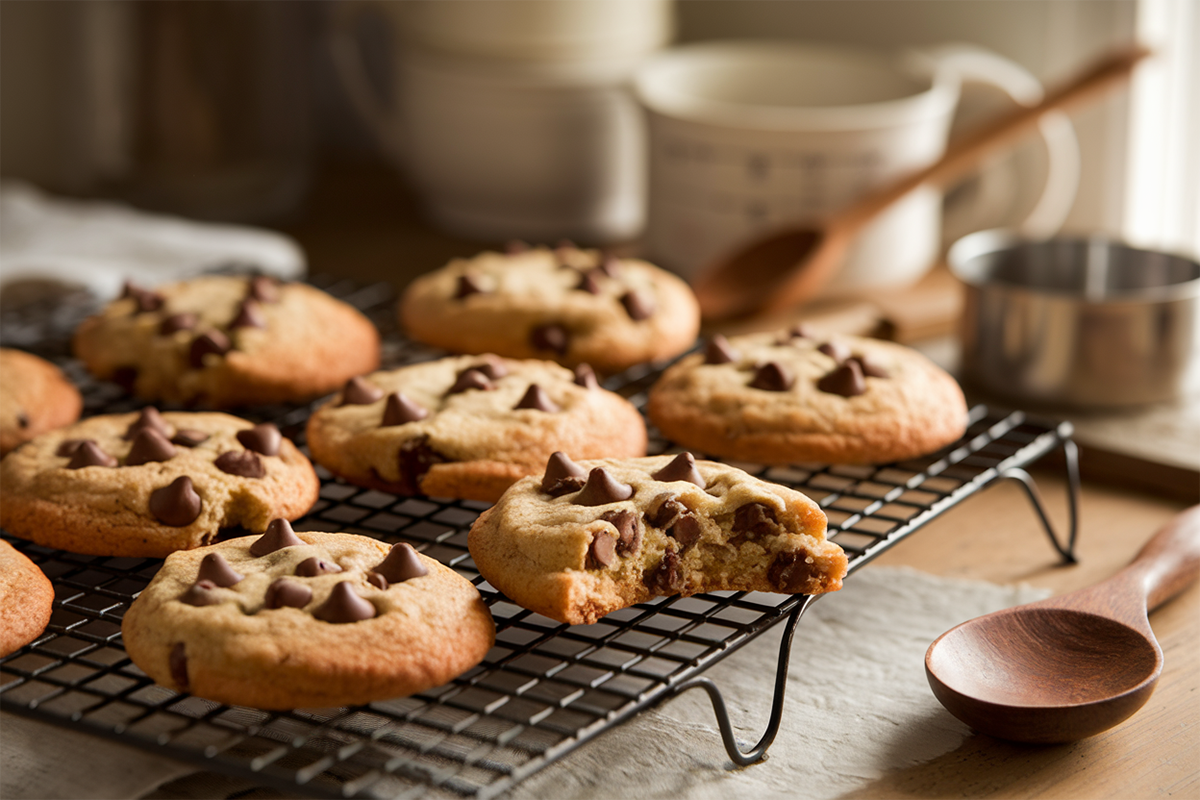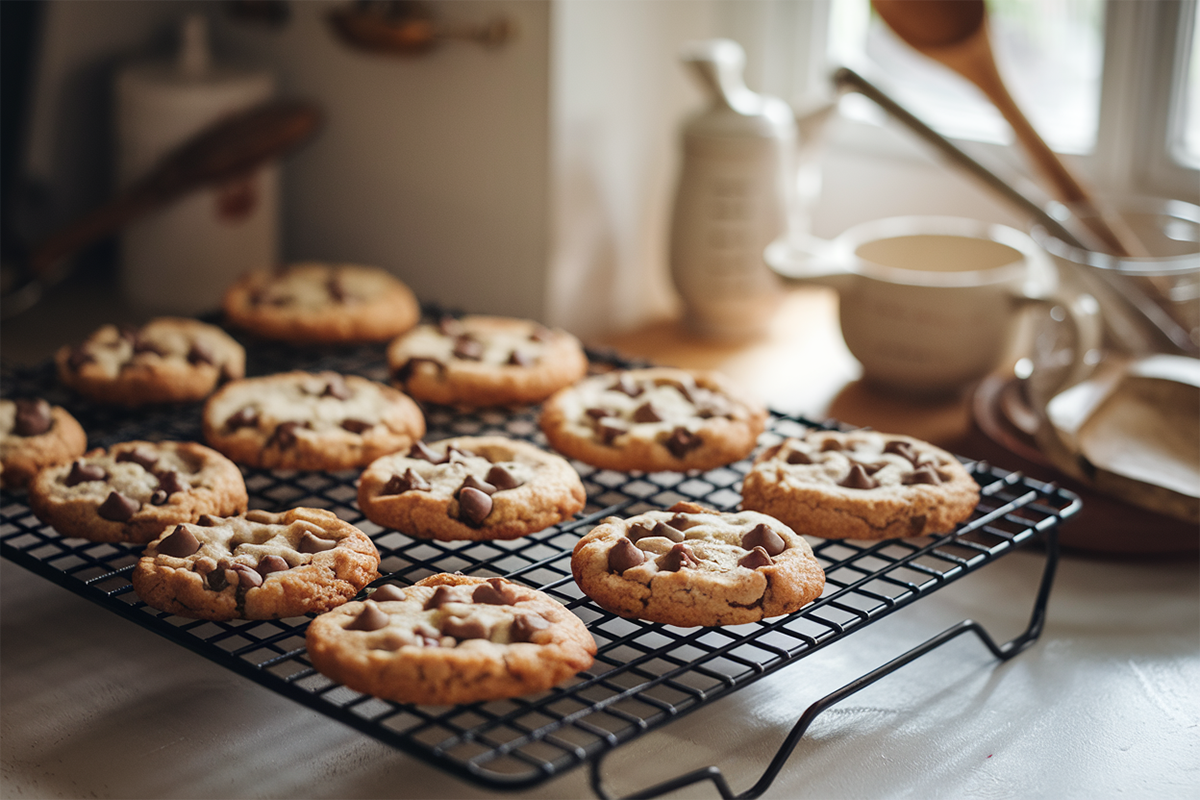Introduction to Crunchy Chocolate Chip Cookies Texture
If you’ve ever baked chocolate chip cookies expecting a chewy, gooey center only to end up with crunchy, brittle cookies, you’re not alone. Many home bakers encounter this issue and wonder what went wrong. While crunchy cookies can still be delicious, sometimes you’re aiming for that soft, chewy bite that melts in your mouth. Understanding the science behind cookie baking is key to perfecting the texture of your chocolate chip cookies.
In this article, we’ll explore the common reasons why chocolate chip cookies turn out crunchy instead of chewy and how to fix it. From ingredient choices to baking techniques, we’ll break down everything you need to know to achieve the perfect cookie texture. If you want to dive deeper into cookie science, check out this comprehensive cookie chemistry guide for more insights on baking adjustments.
Table of Contents
Key Ingredients and Their Roles in Crunchy Chocolate Chip Cookies Texture
The key to understanding why your cookies turned out crunchy lies in the ingredients. Each component of your recipe plays a crucial role in determining the final texture of the cookie. Let’s explore some of the most important ingredients.
1. Flour
The amount of flour you use in your cookie dough directly affects its texture. If you use too much flour, the cookies can become dense and dry, resulting in a crunchy texture. On the other hand, using just the right amount of flour ensures a soft, chewy cookie. When measuring flour, it’s important to spoon it into the measuring cup and level it off with a flat edge to avoid packing too much into the cup.
2. Sugar Types
One of the most important factors that determine whether a cookie will be crunchy or chewy is the type of sugar used. White sugar creates a crispier texture because it lacks the moisture found in brown sugar. If you want a chewier cookie, it’s best to use more brown sugar, which contains molasses and adds moisture to the dough.
3. Butter
Butter provides both flavor and texture in cookies. Using softened butter typically leads to a softer cookie, while using melted butter creates a denser, chewier texture. However, if the butter is over-softened, it can spread too quickly in the oven, resulting in thin and crispy cookies. A balance between softened and cold butter is ideal for achieving chewy cookies with a tender bite.
For more in-depth tips on adjusting your ingredients for the perfect cookie texture, check out these cookie troubleshooting tips.
Common Mistakes That Lead to Crunchy Chocolate Chip Cookies
There are a few common baking mistakes that can cause your cookies to come out crunchy instead of chewy. By identifying and correcting these issues, you can improve your chances of baking the perfect chewy chocolate chip cookies.
1. Overbaking
Overbaking is one of the most frequent culprits behind crunchy cookies. If the cookies are left in the oven for too long, they lose moisture, resulting in a dry, crispy texture. To avoid this, keep a close eye on the cookies during the final minutes of baking. The edges should be golden brown, but the center should still look slightly underbaked. Cookies continue to cook as they cool on the baking sheet.
2. Baking at Too High a Temperature
If your oven is set at too high a temperature, the cookies can set too quickly on the outside, thus leading to a crunchy texture. Ideally, a good temperature for baking chewy chocolate chip cookies is around 350°F (175°C). However, if you find your cookies are turning out too crispy, try lowering the temperature slightly and baking them for a few minutes longer.
3. Incorrect Oven Calibration
Sometimes the issue isn’t with your ingredients but with your oven. If your oven runs hotter than the temperature you set, it can lead to overbaked and crunchy cookies. You can use an oven thermometer to check the accuracy of your oven’s temperature. If you find that your oven is running too hot, adjust the temperature accordingly to prevent your cookies from overbaking.

Cookie Chemistry: Why Ingredients Matter
Fully understanding the chemistry behind cookie baking is crucial to mastering the art of chewy chocolate chip cookies. Furthermore, here’s a closer look at how each ingredient directly impacts the final result.
1. The Role of Sugar in Crunchy Chocolate Chip Cookies
As mentioned earlier, white sugar tends to create a crispier cookie, while brown sugar adds moisture, making cookies chewier. The molasses in brown sugar retains moisture during baking, which is why it’s crucial to achieving a chewy texture. If your cookies are turning out too crispy, consider adjusting the sugar ratio in your recipe by adding more brown sugar.
2. The Role of Fats
The type of fat you use in your cookie dough also plays a significant role in texture. Butter, for instance, melts at a lower temperature than shortening or margarine, leading to more spread and a softer cookie. If you want a chewier cookie, opt for butter or a combination of butter and shortening for the perfect texture.
3. The Role of Liquid
Moisture is essential for chewy cookies. If your dough is too dry, the cookies will turn out crispier. Adding an extra egg yolk or a tablespoon of milk can help retain moisture in the dough, resulting in a chewier cookie. Additionally, chilling the dough before baking helps the cookies retain more moisture, leading to a thicker, softer texture.
Tips for Making Chewy Chocolate Chip Cookies Instead of Crunchy Ones
Now that you understand why your cookies may be turning out crunchy, let’s dive into some actionable tips to help you bake the perfect chewy chocolate chip cookies.
1. Adjust the Baking Time
One of the easiest ways to ensure your cookies stay chewy is to reduce the baking time. Rather than waiting for the entire cookie to turn golden brown, remove them from the oven when the edges are just starting to set, but the center still looks slightly undercooked. As the cookies cool on the baking sheet, they will continue to firm up.
2. Use More Brown Sugar
Since brown sugar contains more moisture than white sugar, increasing the amount of brown sugar in your recipe can help create a chewier cookie. Try using a higher ratio of brown sugar to white sugar for a softer texture.
3. Chill the Dough
Chilling the dough for at least 30 minutes before baking can make a big difference in texture. When the dough is cold, the fat takes longer to melt, preventing the cookies from spreading too much in the oven. This leads to thicker, chewier cookies with a soft center.
4. Increase the Egg Yolk
Additionally, adding an extra egg yolk to your dough can significantly help increase the moisture content, resulting in chewier cookies. Moreover, the egg yolk provides richness and tenderness, which helps keep the cookies soft.
5. Don’t Overmix the Dough
Overmixing your cookie dough can lead to tough, crunchy cookies. When mixing the ingredients, stop as soon as the dough comes together. Overworking the dough develops too much gluten, which leads to a harder texture.
6. Use Room Temperature Ingredients
Make sure your butter and eggs are at room temperature before mixing them into the dough. Room temperature ingredients blend more easily and evenly, which helps create a softer cookie.
How to Fix Crunchy Chocolate Chip Cookies
If your cookies have already turned out crunchy, don’t worry! There are a few tricks you can use to soften them after they’ve baked.
1. Use a Damp Paper Towel
One of the easiest and quickest ways to soften crunchy cookies is to place them in an airtight container with a damp paper towel. Gradually, the moisture from the paper towel will transfer to the cookies, softening them over time. However, be sure the paper towel isn’t touching the cookies directly, as you don’t want them to become soggy.
2. Re-bake at a Lower Temperature
You can also try re-baking the cookies at a lower temperature for a shorter time to soften them. Simply set your oven to 300°F (150°C) and bake the cookies for about 5 minutes. This process allows the cookies to gradually absorb some moisture and soften slightly.
3. Store in a Humid Environment
Another trick is to store the cookies in a humid environment. If you live in a dry climate, storing the cookies in a container with a slice of bread or a damp paper towel can help soften them over time.

Popular Cookie Variations and Texture Preferences
Everyone has a different preference when it comes to cookie texture. Some people love their cookies thin and crispy, while others prefer them soft and chewy. Here’s a breakdown of popular cookie texture variations and how to achieve them.
1. Thin and Crispy Cookies
If you prefer a thin and crispy cookie, simply use more white sugar and less flour. As a result, this combination will help the cookies spread more in the oven, eventually creating a crunchy texture.
2. Soft and Chewy Cookies
For soft and chewy cookies, increase the amount of brown sugar and butter in your recipe. Additionally, baking at a lower temperature for a shorter time will help keep the cookies soft.
3. Thick and Chewy Cookies
If you’re aiming for thick and chewy cookies, chill the dough before baking, and use a higher ratio of flour to prevent the cookies from spreading too much in the oven.
Frequently Asked Questions (FAQs)
1. Why did my chocolate chip cookies turn out crunchy instead of chewy?
Your cookies may have turned out crunchy due to overbaking, using too much white sugar, or baking at a high temperature. These factors cause the cookies to lose moisture and become crispier.
2. Can I make crunchy chocolate chip cookies softer?
Yes, you can easily make crunchy cookies softer by placing them in an airtight container with a damp paper towel. Alternatively, you can re-bake them at a lower temperature for a few minutes.
3. Why does brown sugar make cookies chewy?
Brown sugar contains molasses, which adds moisture to the dough and results in a chewier texture. The molasses also helps retain moisture during baking.
4. How does chilling the dough affect cookie texture?
Chilling the dough before baking helps the fat solidify, which prevents the cookies from spreading too much in the oven. This leads to thicker, chewier cookies with a soft center.
5. Can I fix cookies that are too crunchy?
Yes, you can definitely try softening crunchy cookies by either re-baking them at a lower temperature or storing them with a damp paper towel.
Conclusion: Mastering Crunchy Chocolate Chip Cookie Texture
Mastering the texture of chocolate chip cookies takes a bit of trial and error, but by adjusting your ingredients and techniques, you can avoid making them too crunchy. Remember, it’s the balance of sugar types, baking time, and oven temperature that makes all the difference. If you’re looking for more cookie recipes to try, check out these delicious Lazy Chocolate Chip Cookie Bars for a softer texture. Also, for those who enjoy experimenting with desserts, you might like this Strawberry Crunch Cheesecake for a sweet and crunchy twist.

